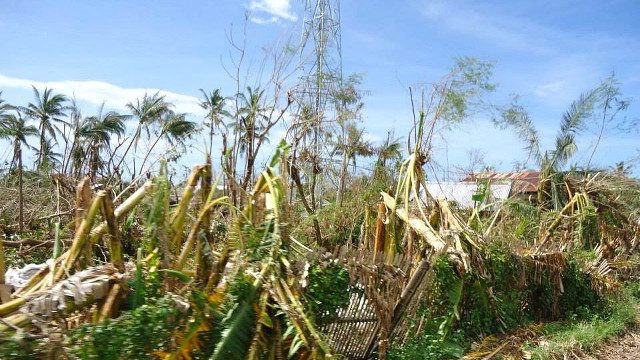SUMMARY
This is AI generated summarization, which may have errors. For context, always refer to the full article.

MANILA, Philippines – Two months after Typhoon Yolanda (Haiyan) smashed into Visayas, the Department of Agriculture expects it will need P9.17 billion to rehabilitate the agriculture and fisheries sector in the affected regions.
According to a January 7 summary report given to Rappler on Wednesday, January 8, the sum is divided into two major needs.
The rehabilitation of livelihood will cost P6.93 billion for interventions like farmland clearing operations, provision of seeds, farm tools, fertilizer, provision of boats for fishermen, desilting of irrigation canals and coconut rehabilitation.
Infrastructure rebuilding will cost P2.23 billion for constructing fish ports, irrigation facilities and post-harvest facilities.
The DA’s latest tally pegs total Yolanda damage at P31.13 billion.
Of this, P27 billion represents damage to crops like rice, corn, coconut, cassava, banana and vegetables. The coconut sector was the most damaged, with up to P17.8 in production loss.
The super typhoon also damaged P4.06 billion worth of facilities and infrastructure used by farmers and fishermen like post-harvest facilities and boats.
The staggering amount of damage has compromised the source of income of more than 200,000 farming and fishing households and around 870,000 individuals, estimates the DA.
Even without Yolanda’s devastation, farmers and fishermen are the most vulnerable sector in the country.
According to the National Statistics Coordination Board, farmers and fishermen are the lowest paid workers in the country. Poverty incidence among fishermen and farmers was the highest in 2009. It’s natural disasters like typhoons that keep many of them below the poverty line. (READ: NSCB: Many Pinoys remain poor due to disasters)
What has been done
The DA reports that actions have been taken to help farmers and fishermen rebuild their livelihood.
For farmers, the DA has provided production inputs like seeds for crops and fertilizer. Here is the breakdown:
Procured for distribution:
- 1,667 bags of corn seeds (1,367 bags of yellow corn and 300 bags of white corn)
- 6,313 kilograms of assorted vegetable seeds
- 57,500 fruit seedlings
- 150,000 cuttings of root crops
- 23,316 bags of certified seeds
Distributed:
- 19,208 bags of certified seeds
- 14,044 bags of fertilizers
The department also continues to procure farm tools for distribution. So far, 181 chainsaws have been sent to the affected regions while 10,344 sets of farm tools have been delivered.
For fishermen, the DA has provided materials to build up to 1,000 units of small boats (banca). They aim to build 10,000 boats in 3 months.
To this end, they’ve identified strategic locations for boat-making stations such as Guiuan and Maasin in Leyte, Catbalogan in Samar, Carmen in Cebu and Iloilo.
A total of 3,000 small boats and 1,500 units of marine engines have been allocated to fishermen.
They have delivered 2.5 tons of nails and 100 sacks of cement for the construction of payao, fish aggregating devices where small fish gather thereby attracting bigger fish. Fishermen can use payao to catch fish while their boats are being constructed, said the report.
Aside from providing equipment, the DA says it has deployed personnel from its national and regional offices to conduct regional planning workshops, field validations, geo-tagging of damaged infrastructure and facilities and to provide technical and administrative support to rehabilitation operations.
The agency is also coordinating with various international groups who have committed to give support such as the International Fund for Agricultural Development (IFAD), Korean International Cooperation Agency (KOICA), Overseas Workers Welfare Administration (OWWA) and the Asian Development Bank (ADB).
More work ahead
But more needs to be done.
The DA reports that 153,495 hectares of farmland still have to be cleared if new crops are to be planted.
More than 98,000 farmers are yet to receive seeds and fertilizers while more than 38,000 farm households still have not been given farm tools.
More than 146,000 fisherfolk are yet to be provided boats and fishing gear.
According to rehabilitation czar Panfilo Lacson, the government aims to fully rehabilitate Yolanda-hit regions by 2017.
The colossal undertaking is the country’s biggest reconstruction effort since the end of World War II. The government’s rehabilitation plan pegs total recovery costs to be around P360.9 billion (US$8.17 billion). – Rappler.com
Add a comment
How does this make you feel?
There are no comments yet. Add your comment to start the conversation.